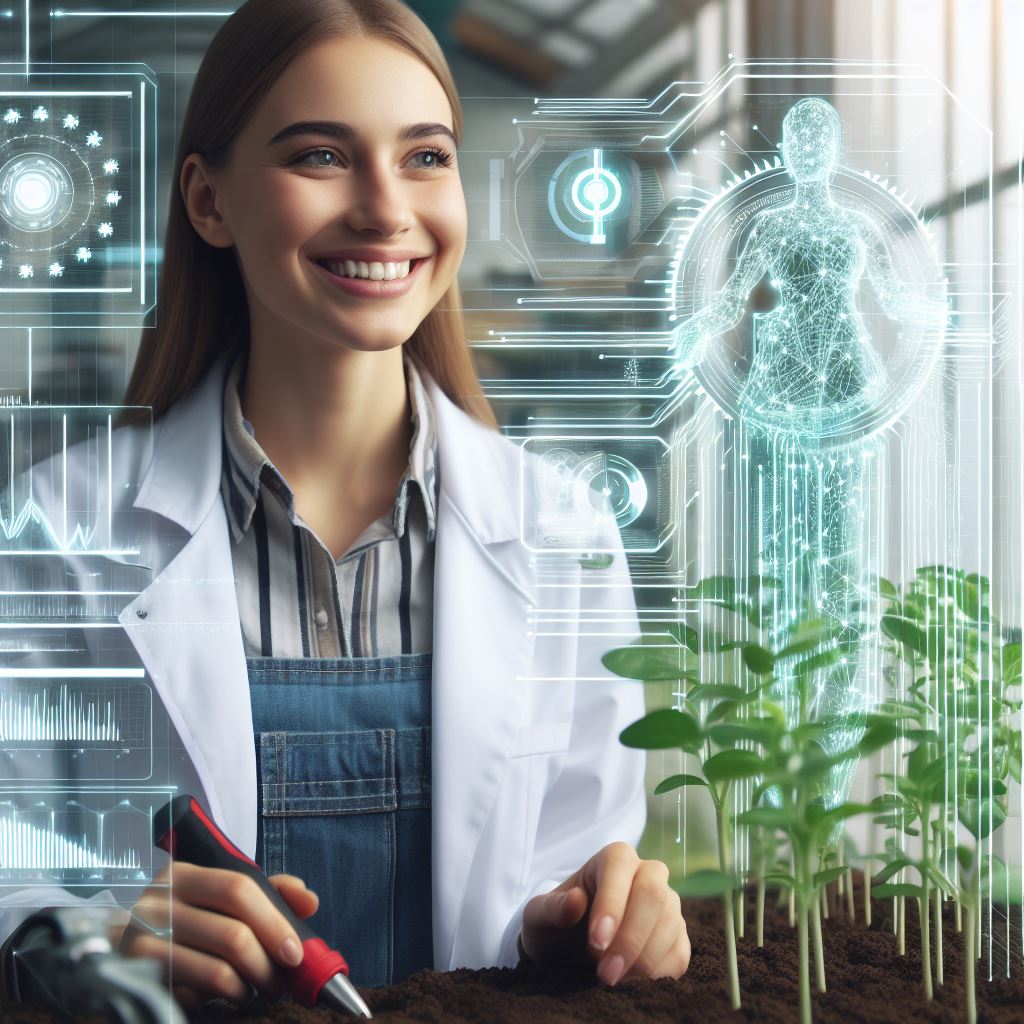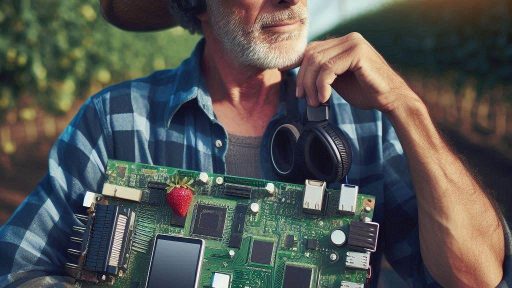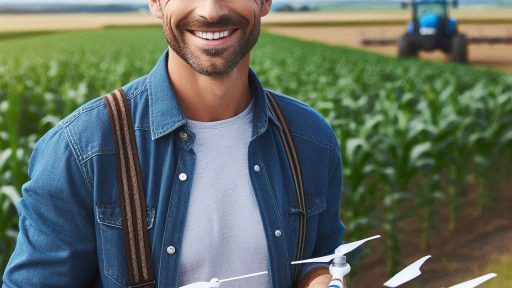Introduction
Robotics in organic farming revolutionizes agricultural practices, leading to increased efficiency and sustainability.
This blog post aims to provide insights into the significance and impact of this technology.
Organic farming promotes the use of natural resources and techniques that minimize environmental harm.
However, labor-intensive tasks often hinder its scalability. Here’s where robotics comes into play.
With the advancements in robotics, farmers can automate various tasks previously done manually.
These include planting, harvesting, and crop monitoring, significantly reducing labor requirements.
By enabling automation, robotics enhances productivity in organic farming.
Moreover, robotics ensures precision in farming operations.
Robots equipped with sensors and cameras can analyze soil conditions, detect diseases, and improve pest management.
This technology enables farmers to make data-driven decisions, leading to optimized resource usage and reduced environmental impact.
Additionally, robotics helps address the challenge of labor scarcity in agriculture.
As labor costs rise, farmers face difficulties in finding and retaining skilled workers.
By adopting robots, farmers can overcome these challenges and reduce labor dependency.
In summary, robotics in organic farming offers numerous benefits.
It improves agricultural productivity, enhances sustainability, and mitigates labor challenges.
As we journey through this blog post, we will delve deeper into specific applications and explore future prospects of this transformative technology.
Benefits of Robotics in Organic Farming
Improved efficiency and productivity
- Robots can perform repetitive tasks with consistency and precision, increasing overall efficiency.
- They can work around the clock without fatigue, maximizing productivity and reducing delays.
- Robotic systems can optimize planting, fertilizing, and harvesting processes, streamlining operations.
Reduction in labor costs
- Robots can replace human manpower in labor-intensive tasks, reducing the need for manual labor.
- This can lead to significant cost savings in the long run, as robots only require maintenance and programming.
- By decreasing labor costs, organic farmers can invest in other areas of their operations or expand their businesses.
Minimization of chemical usage
- Robots can precisely apply fertilizers, herbicides, and pesticides in targeted amounts, minimizing waste.
- They can detect and treat specific plant diseases and pests, reducing the need for broad-spectrum chemicals.
- By reducing chemical usage, robotic systems contribute to the preservation of soil and water quality.
Enhanced crop quality and yield
- Robots can monitor crops continuously, ensuring optimal growing conditions and early detection of problems.
- They can provide precise irrigation and nutrition, leading to improved crop health and higher yields.
- Robotic systems can also selectively harvest ripe crops, minimizing waste and ensuring better quality produce.
Promotion of sustainable practices
- Robotic farming enables the use of precision agriculture techniques, minimizing environmental impact.
- By reducing chemical usage and optimizing resource allocation, it supports sustainable farming practices.
- Robots can contribute to soil conservation, biodiversity preservation, and water resource management.
Generally, the integration of robotics in organic farming offers numerous benefits to farmers and the environment.
It improves efficiency and productivity by automating repetitive tasks, reduces labor costs, and minimizes chemical usage.
Moreover, robotic systems enhance crop quality and yield, promoting sustainable farming practices.
With continuous advancements in robotics technology, the future of organic farming looks promising, combining innovation and eco-friendly practices.
Read: Data-Driven Livestock Nutrition Plans
Applications of Robotics in Organic Farming
By employing robotics in organic farming, several benefits can be achieved.
Firstly, it increases efficiency by automating labor-intensive tasks, reducing the need for manual labor.
Secondly, it improves accuracy and precision, leading to better crop yields and healthier plants.
Furthermore, it minimizes the use of chemical pesticides, thus promoting environmentally-friendly farming practices.
Crop planting and seeding
In crop planting and seeding, robots are programmed to complete tasks at a faster pace and with higher precision than humans.
They can plant seeds at optimal depths and spacing, ensuring uniform growth and reducing seed wastage.
Moreover, these robots can operate 24/7, allowing for continuous planting even during unfavorable weather conditions.
Crop monitoring and management
Crop monitoring and management robots are equipped with various sensors and cameras to gather data on crop health.
They can detect diseases or nutrient deficiencies at early stages, enabling timely intervention and preventing crop losses.
Furthermore, these robots can autonomously apply fertilizers or organic pest control measures, promoting sustainable farming practices.
Weed control and elimination
Weed control is a major challenge in organic agriculture, as chemical herbicides are not permitted.
Robotic systems use advanced imaging technology to identify and differentiate between crops and weeds.
They can then selectively target and remove the unwanted plants, reducing competition for resources and improving crop yield.
Harvesting and post-harvesting tasks
Harvesting and post-harvesting tasks are physically demanding and time-consuming.
Robots equipped with sensitive grippers and vision systems can accurately identify ripe fruits or vegetables.
They can gently harvest crops, maintaining their quality and reducing the risk of damage during transportation.
These robots can also sort and pack the produce, minimizing post-harvest losses and ensuring longer shelf life.
Soil and environmental monitoring
Soil and environmental monitoring robots continuously collect data on various soil parameters and environmental conditions.
By analyzing this data, farmers can optimize irrigation schedules, prevent overwatering or drought, and ensure proper soil nutrient management.
This leads to improved crop quality, reduced water usage, and enhanced resource efficiency.
In fact, the applications of robotics in organic farming are vast and promising.
From crop planting to post-harvesting tasks, robots bring numerous benefits to farmers.
They improve efficiency, minimize environmental impact, and enhance crop quality.
As technology continues to advance, the integration of robotics in organic farming is expected to increase, revolutionizing the way we cultivate and produce food sustainably.
Transform Your Agribusiness
Unlock your farm's potential with expert advice tailored to your needs. Get actionable steps that drive real results.
Get StartedRead: Innovations in Livestock Comfort Control

Examples of Robotic Technologies in Organic Farming
The use of robotic technologies in organic farming has gained significant attention in recent years.
These advancements have revolutionized the way farmers manage their crops and have provided numerous benefits in terms of efficiency, sustainability, and cost-effectiveness.
Autonomous drones for crop monitoring
One example of robotic technology in organic farming is the use of autonomous drones for crop monitoring.
These drones are equipped with sensors and cameras that allow them to fly over fields, capturing high-resolution images and collecting data on crop health.
Farmers can then analyze this data to identify areas that require attention, such as pest infestations or nutrient deficiencies.
By using autonomous drones, farmers can quickly and accurately assess the health of their crops, allowing for timely interventions and maximizing yields.
Robotic weeders and tillers
Another robotic technology commonly used in organic farming is robotic weeders and tillers.
These robots are designed to navigate fields and identify and remove unwanted weeds without damaging the crops.
With their advanced imaging systems and smart algorithms, these robots can distinguish between crops and weeds, thus reducing the need for manual labor-intensive weeding processes.
Robotic weeders and tillers not only save time and labor costs but also eliminate the use of herbicides, making organic farming practices even more sustainable.
Harvesting robots
Harvesting robots have also emerged as a valuable asset in organic farming.
These robots are programmed to identify ripe fruits or vegetables and pick them with precision.
By automating the harvesting process, farmers can reduce labor costs and increase efficiency.
Harvesting robots can work tirelessly without fatigue, ensuring a faster and more efficient harvest.
Additionally, these robots can minimize crop damage compared to traditional manual harvesting methods, preserving the quality of the organic produce.
Sensory technologies for soil analysis
Sensory technologies have also found their way into organic farming.
Robotic devices equipped with sensors can analyze soil composition, moisture levels, and nutrient content.
This data can help farmers make informed decisions about fertilization, irrigation, and soil management.
By accurately assessing soil conditions, farmers can optimize resource usage and minimize the risk of nutrient imbalances or overwatering in organic farming.
Robotic devices for precision agriculture
Lastly, robotic devices for precision agriculture have proven to be invaluable for organic farmers.
Automated planters and irrigation systems can ensure accurate planting depths and optimal water distribution, contributing to healthier crop growth.
These devices can be programmed to adjust planting density and water application based on crop requirements, resulting in even growth and better yields.
By using robotic devices for precision agriculture, organic farmers can maximize the potential of their crops while reducing water and fertilizer waste.
In review, the integration of robotic technologies in organic farming has brought about significant advancements in crop monitoring, weed control, harvesting, soil analysis, and precision agriculture.
These technologies provide farmers with precise and efficient tools to optimize crop management, enhance sustainability, and improve overall productivity in organic farming practices.
As technology continues to advance, the potential for further innovation in this field is vast, promising an even more sustainable and productive future for organic farming.
Read: Tech in Veterinary Care: Modern Approaches
Delve into the Subject: Yield Boosting: Robotics in Action
Challenges and Limitations of Robotics in Organic Farming
High initial investment costs
Implementing robotics in organic farming requires a significant upfront investment, which can be a challenge for farmers who have limited financial resources.
The cost of purchasing robots, sensors, and other equipment can be prohibitively high.
Compatibility with organic farming guidelines
Organic farming adheres to strict guidelines that prohibit the use of synthetic chemicals and genetically modified organisms.
Integrating robotics into organic farming practices may require careful attention to ensure compliance with these guidelines.
Limited data availability and standardization
There is a lack of comprehensive data and standardization in the field of robotics in organic farming.
This makes it difficult for farmers to assess the effectiveness of robotic systems and make informed decisions.
Maintenance and technical issues
Robotics systems require regular maintenance and may experience technical issues.
Farmers need to have the necessary technical knowledge and skills to address these problems promptly to prevent disruptions in their farming operations.
Potential job displacement concerns
The introduction of robotics in organic farming raises concerns about potential job displacement.
As robots take over certain tasks, there is a risk of reducing employment opportunities for farm workers.
Despite these challenges and limitations, it is important to recognize the potential benefits that robotics can bring to organic farming.
By addressing these challenges, the integration of robotics in organic farming can be optimized for maximum efficiency and sustainability.
Read: Virtual Fencing: The Future of Herding
Learn More: Future of Farming: Drone Technology
Future Perspectives of Robotics in Organic Farming
In recent years, robotics has made significant advancements in the field of organic farming.
As technology continues to evolve, the future of robotics in agriculture looks promising.
Here are some future perspectives that can revolutionize organic farming:
Integration of artificial intelligence and machine learning
One of the key areas of development in robotics is the integration of artificial intelligence (AI) and machine learning algorithms.
The use of AI can enable robots to make autonomous decisions based on real-time data analysis.
By incorporating machine learning algorithms, robots can learn and adapt to different farming conditions.
They can analyze soil quality, detect diseases, and make informed decisions to optimize crop yield and minimize pesticide usage.
Development of multi-purpose robotic systems
One of the challenges in robotics is creating robots that can perform multiple tasks efficiently.
Future perspectives envision the development of multi-purpose robotic systems that can perform various farming activities.
For instance, a robot can simultaneously perform planting, weeding, and harvesting tasks.
This not only improves overall efficiency but also reduces labor costs for farmers.
These multi-purpose robots can enhance productivity and enable farmers to focus on more complex tasks.
Collaboration between farmers, scientists, and robotics experts
In order to fully harness the potential of robotics in organic farming, collaboration between farmers, scientists, and robotics experts is crucial.
Farmers’ first-hand knowledge of their fields can guide the development of effective robotic solutions.
Showcase Your Farming Business
Publish your professional farming services profile on our blog for a one-time fee of $200 and reach a dedicated audience of farmers and agribusiness owners.
Publish Your ProfileScientists can contribute by conducting research on crop behavior, soil analysis, and disease identification.
Robotics experts can apply their skills to develop robots that address specific farming challenges.
Together, this collaboration can lead to innovative solutions that benefit the entire industry.
Increased research and funding for innovation
In order to bring about significant advancements in robotics for organic farming, increased research and funding are essential.
Governments, organizations, and private investors should allocate resources towards research and development in this field.
By investing in robotics, there will be more opportunities to explore new technologies and techniques that can revolutionize farming practices.
Increased funding can drive innovation, leading to the development of more sophisticated and efficient robotic systems.
Regulation and policy development to support robotic technologies
As robotics becomes more prevalent in organic farming, it is important to have proper regulation and policy development to support their implementation.
This includes guidelines for safety, data privacy, and ethical considerations.
National and international regulatory bodies need to collaborate with industry experts to ensure that the use of robotics in farming aligns with ethical and environmental standards.
This will boost confidence in robotic technologies and ensure their responsible deployment.
In a nutshell, the future of robotics in organic farming holds immense potential.
Integrating artificial intelligence, developing multi-purpose robots, collaboration between stakeholders, increased research and funding, and supportive regulations can unlock the true benefits of robotics in agriculture.
Conclusion
Recap of Benefits
The adoption of robotic technologies offers organic farming numerous advantages.
These include heightened efficiency in tasks like planting, weeding, and harvesting.
By automating repetitive and labor-intensive processes, robots significantly reduce manual labor needs.
They also enable precise resource application, minimizing chemical usage and promoting eco-friendly practices.
Moreover, robotic systems gather data for optimized crop management, leading to improved yields and resource efficiency.
Overall, integrating robotics into organic farming enhances productivity while aligning with sustainability principles.
Encouragement for Farmers
Embracing robotic technologies presents a significant opportunity for organic farmers.
These advanced tools can unlock efficiency and productivity levels previously unattainable.
By incorporating robotics, farmers streamline operations, mitigate labor shortages, and maintain organic standards effectively.
This adoption ensures competitiveness in the evolving agricultural landscape while upholding sustainability principles.
Call-to-action for Readers
Staying informed about robotic farming advances is vital for stakeholders.
It provides insights into emerging trends, best practices, and potential opportunities.
By keeping abreast of these developments, individuals can make informed decisions about integrating robotics into their organic farming practices.
This proactive approach contributes to the advancement of sustainable and efficient organic agriculture.




